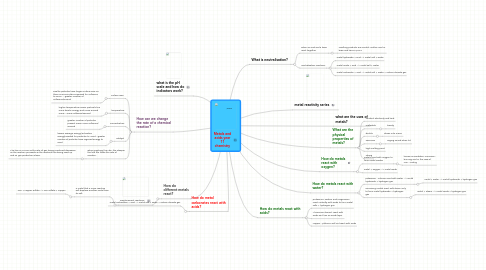
1. what is the pH scale and how do indicators work?
2. How do metal carbonates react with acids?
2.1. metal carbonates + acid --> metal salt + water + carbon dioxide gas
3. How do different metals react?
3.1. Displacement reactions.
3.1.1. a metal that is more reactive will displace another metal from its salt.
3.1.1.1. iron + copper sulfate --> iron sulfate + copper
4. How can we change the rate of a chemical reaction?
4.1. surface area
4.1.1. smaller particles have larger surface area, so there is more surface exposed for collisions to occur.... greater number of collisions/second
4.2. temperature
4.2.1. higher temperature means particels hve more kinetic energy and move around more....more collisions/second
4.3. concentration
4.3.1. greater number of particles present mean more collisions/ second
4.4. catalyst
4.4.1. lowers average energy (activation energy)needed for pariticles to react...greater number of particles have reguired energy to react
4.5. when graphing the rate, the steeper the line the faster the rate of reaction.
4.5.1. The line is a curve as the rate of gas being produced decreases as the reaction proceeds as the reactants are being used up and so gas production slows.
5. Vvvvv
6. What are the physical properties of metals?
6.1. conduct electricity and heat
6.2. malleable
6.2.1. bendy
6.3. ductile
6.3.1. drawn into a wire
6.4. sonorous
6.4.1. ringing sound when hit
6.5. high melting point
6.6. strong
7. How do metals react with oxygen?
7.1. metals react with oxygen to form metal oxides
7.1.1. known as oxidation, corrosion, burning and in the case of iron...rusting
7.2. metal + oxygen --> metal oxide
8. How do metals react with water?
8.1. potassium - calcium react with water --> metal hydroxide + hydrogen gas
8.1.1. metal + water --> metal hydroxide + hydrogen gas
8.2. remaining metals react with steam only to form metal hydroxide + hydrogen gas
8.2.1. metal + steam --> metal oxide + hydrogen gas
9. How do metals react with acids?
9.1. potassium, sodium and magnesium react violently with acids to form metal salts + hydrogen gas
9.2. Aluminium doesn't react with acids as it has an oxide layer
9.3. copper - platnium will not react with acids
10. What is neutralisation?
10.1. when an acid and a base react together
10.1.1. resulting products are neutral, neither acid or base and have a pH=7
10.2. neutralisation reactions
10.2.1. metal hydroxide + acid --> metal salt + water
10.2.2. metal oxide + acid --> metal salt + water
10.2.3. metal carbonate + acid --> metal salt + water + carbon dioxide gas
